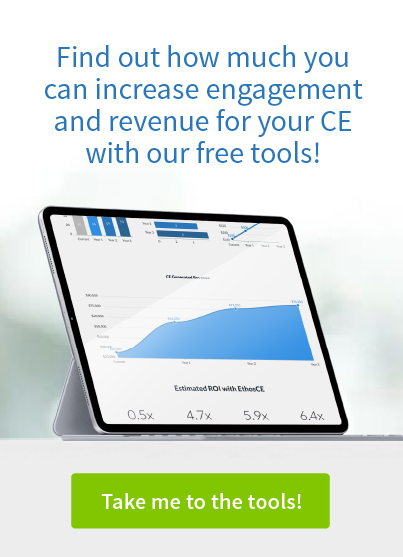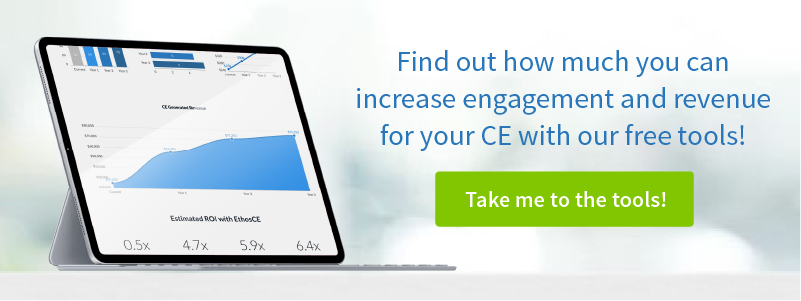3 Fronts Where A CME LMS Deserves The Name “Learning Management Solution”
In CME Today, Not All Systems and Software Platforms Are Truly Solutions.
Most people in the CME industry learned long ago that the acronym “LMS” stands, in that context, for “learning management system,” “learning management software,” or “learning management solution.”
We treat these phrases more or less as synonyms. All refer to a method of designing, delivering, and documenting the courses and learning activities our organization’s practitioners need to advance their lifelong medical learning.
But are the terms really interchangeable?
A “system” doesn’t have to be “software.” Classroom lectures, grand rounds, and live conferences are all non-computerized systems for managing learning.
And neither an electronic nor a traditional “system” is necessarily a solution.
Doctors, nurses, physician assistants, and other healthcare professionals engage in CME not for their own personal enrichment (although good CME can feel personally satisfying), but, as the ACCME definition of CME explains, in order to “provide services for patients, the public, or the profession.”
In other words, a true learning management solution arguably does more than play videos and track CE credits. The best learning management system actively contributes to the acquisition of knowledge that benefits patients and society. Its features help equip practitioners to be medical problem-solvers.
The Right LMS Sparks Real Learning Solutions In Healthcare Today
Here are three fronts on which rapid, relevant CME must be deployed—along with specific ways in which a strong LMS can become a true, and truly needed, learning solution:
1. Meeting The Opioid Crisis With Multimedia Learning
The New York Times calls it “America’s 50-state epidemic.” Opioid addiction threatens health and claims lives at a frightening rate. According to the CDC, drug overdose deaths involving opioids—not only heroin but also physician-prescribed painkillers—has quadrupled since 1999, and 91 Americans die from an opioid overdose each day.
This challenge to public health demands that healthcare professionals master new knowledge. As a result, more CME options are emerging to address the opioid crisis. Earlier this year, for example, the AMA released a new module entitled “A Primer on the Opioid Morbidity and Mortality Crisis: What Every Prescriber Should Know.”
The module helps redress what it describes as the “[i]nadequate training across the continuum of medical education in pain management” that has contributed to the epidemic. It uses engaging multimedia features—”animation, infographics, and storytelling”—to teach clinicians.
Interactive multimedia is crucial in modern CME, so any LMS intended to be a true learning solution must support it.
2. Designing Education About The “Antibiotic Timeout”
Increased bacterial resistance to antibiotics is another fairly recent public health problem that medical educators are meeting with innovative learning solutions. In 2015, for instance, Stanford University’s School of Medicine debuted an online course called “Optimizing Antimicrobial Therapy with Timeouts.”
The course promotes an “antibiotic timeout.” Clinicians are encouraged to reassess antibiotics’ effectiveness 2-3 days after starting patients on the drugs. Dr. Marisa Holubar told the Stanford Medicine News Center she helped develop the course to equip clinicians with training they “don’t necessarily have” but need in order to avoid overprescribing antibiotics.
This course also maximizes the multimedia, interactive aspects of a robust LMS. It relies not on lectures but on narrated and amply illustrated case studies—an optimal practice in CME instructional design. Any learning solution highlighting real-world relevance will help learners more than courses that stay at a purely academic level.
3. Registering And Connecting Learners In Cannabis Curricula
It’s not always current epidemics or potential pandemics that drive new CME initiatives! Public policy can, too. Changing laws can often almost instantly create knowledge and practice gaps that healthcare professionals must remedy as quickly as possible.
Case in point: in recent years, according to Governing magazine, 26 states and the District of Columbia have “broadly legaliz[ed] marijuana in some form,” from medicinal to recreational. Physicians have been seeking CME around a substance that, for most of their careers, has been illicit.
New laws bring new regulations, requiring practitioners to acquire up-to-date knowledge before prescribing cannabis. In response, the Massachusetts Medical Society created a course in which doctors, nurses, and pharmacists across the country can communicate and collaborate with each other on the subject, sharing knowledge and practical treatment advice.
Here in EthosCE’s home state of Pennsylvania, over 100 physicians registered online for cannabis-focused CME in one week once the chance to become certified in recommending (not prescribing) cannabis became available. The CEO of one training company reported, “The phone is ringing off the hook.”
Learning management system vendors in situations like these must have the capacity to rapidly and accurately manage enrollments and reliable tools which enable peer-to-peer collaborative learning. Then their products can truly be solutions for helping practitioners respond quickly and effectively to changing medical priorities in the communities they serve.
EthosCE As Your Next Learning Management Solution
Multimedia and interactive capabilities. Attention to high standards of instructional design. Registration automation and peer-to-peer networking support. EthosCE includes all of these features, and many more.
If you’re undertaking an LMS comparison in 2017, consider this: we generally call EthosCE a “learning management system,” but the system we’ve designed is a true learning management solution that provides the features that learners need in a constantly changing medical climate.
EthosCE is the industry-leading, SCORM-compliant learning management system designed to automate and modernize the delivery of continuing education in the health professions. We work closely with leading medical associations, academic centers, and health systems to optimize their technology infrastructure and create an easy-to-use and intuitive environment for learners and CME administrators alike. For more information about EthosCE, please contact us at 267-234-7401.
 We're now part of the Cadmium product suite! Learn more
We're now part of the Cadmium product suite! Learn more 

